 |
||
|
||
| ||
MonitorsIn January manufacturers of TFT LCD monitors were constantly discussing the ways of price increasing for their products. But apart there were some unexpected surprises. As you know, Taiwanese companies started lifting their prices yet in October-November and were going to raise them up to $250 by March for 15" models. However, right after the New Year Samsung lowered the wholesale prices for such models, thus making it $5 lower than it was all over Taiwan. Some analysts tried to explain it as an attempt to alleviate a sales slowdown on the TFT LCD market. However, the statistics shows that in 2001 there were 14 million LCD monitors sold, and the forecasts for 2002 say that the figure is going to be 25 million. The volume of orders is increasing and it can result in a shortage of the monitors yet in the middle of 2002 and such deficiency may last a year. 15" displays may go up to $300 but they won't be over $500. 17" and 18" will probably be available at $700 - $900 by the middle of the year. It should be noted, that the Taiwanese manufacturers incurred losses because of price cutting last year. That is why they adopted a program of price increasing by 15 - 20% within 3 months. By the middle of the month Samsung and LG Electronics announced a synchronous raising on their wholesale prices: 15" TFT LCD monitors from Samsung went up by $11.4. In general, the wholesale prices in this industry came close to $235 - $240, and Samsung said that by the end of the quarter 15" displays would be available at not more than $250. In January the Taiwanese association of TFT LCD manufacturers founded an alliance for co-development of advanced technologies. The new alliance includes both governmental and private structures. Some of the expenses are taken by the government. Undoubtedly, such collaboration will let the companies save on R&D works and resist much better to foreign companies. In January one more union appeared: Toshiba Matsushita Display Technology Co., Ltd which will be officially started on April 1 2002 and will produce and sell low-temperature polycrystalline silicon TFT LCDs, amorphous TFT LCD, STN (SuperTwist Nematic) LCDs and OLEDs. Apart from the computer industry LCD displays become very popular with TV-set makers. Thus, by 2005 the market of such TV-sets is going to reach 7 million pcs a year; and in 2002 there must be 1.9 million sets produced. Samsung has already started production of LCD TV-sets with 15.3" and 17" screens and is now preparing 22" and 30" models. The company is also going to start producing its 40" wide-screen LCD TV-sets. The production line designed for TFT LCD matrices of the 5th generation which works with plates up to 1100 x 1250 mm (109") will start production of 30" and 40" monitors in Q2 this year. In January LG-Philips Display announced they were going to lift up release prices for CDTs (color display tube) from February. The price rise is now only 5% -7%. However, it provoked two more companies Samsung and Chunghwa Picture to increase their price as well. But it should be noted that in January the prices for CDTs were at the level of December. The January brought in not only economic news, but also some real new products. Let's take a look at them. 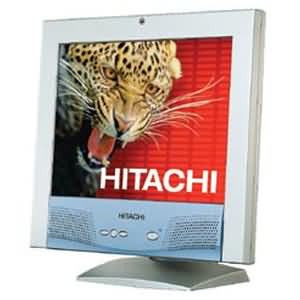 Hitachi introduced an interesting 15" LCD model. The CML155V is both a monitor and a TV screen as it's equipped with a standard VGA, digital DVI-D, composite and S-Video inputs. The maximum brightness is 300 cd/m2, contrast is 500:1, and you can also adjust brightness, contrast, vertical and horizontal positioning, color temperature. Plus, it comes with built-in mic and stereo speakers; the CML155V is priced at $529. Hitachi also released a 18" CML181 LCD supporting Hitachi S-IPS technology (which is meant to increase image quality and lower color noise, as well as to enlarge a viewing angle up to 170 degrees). Although the parameters are standard for a 18" monitor (235 cd/m2, contrast - 300:1, resolution - 1280 x 1024, pixel size - 0.28 mm), the monitor has a quite attractive price - $999. 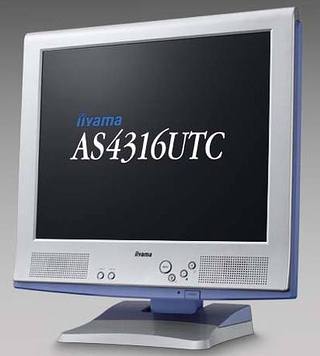 IIYAMA started selling its two new 15" and one 17" TFT LCD monitors. The 17" AS4316UTC ($650) has a standard VGA and a digital DVI-I inputs at a standard for SXGA monitors resolution and a response time of 40 ms. 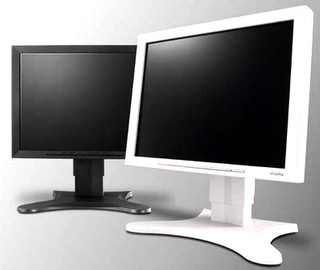 The 15" AS3835UT and AS3835UT-BK ($540) differ only in a case color; they have a good response time of 25 ms, are equipped with analog and digital DVI-D inputs, a 4-port USB hub and a support which allows rotating the screen up to 90 degrees. 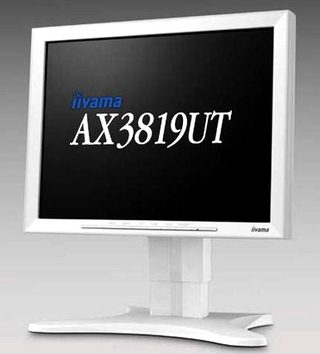 One more inexpensive ($460) 15" model - AS3819UT - is similar to the AS3835UT just without a USB hub and with a response time of 30 ms. NEC Mitubishi Visual released 4 new models last month. Two 15" RDT152X-S and RDT152X-S LCDs, different only in a case color, have standard characteristics (though the maximum brightness is only 200 cd/m2) and an analog-in. The models are priced only at $390. The 17" LCD1720M and 18.1" LCD1850E have quite decent characteristics (maximum resolution - 1280 x 1024, only analog VGA inputs, maximum brightness - 200 cd/m2, contrast of the LCD1720M - 350:1, LCD1850E - 300:1) and rather good prices - $799 and $899 respectively. Sony is going to start mass supplies of the 18" SDM-S81 and 15" SDM-S51 LCDs. The most interesting characteristic is a response time - 20 ms. 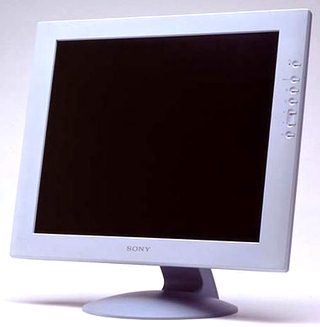 The 18" model with the maximum resolution of 1280 x 1024 supports three modes of white balance, a digital anti-aliasing mode and color balance adjustment. The price is only $930 as there is just one analog-in. However, the monitor comes with an adapter for connection to G3/G4 Mac models. The 15" SDM-S51 ($390) is rather simple, but it lacks for a digital AA mode.  One more 15" TFT LCD called FlexScan L355 was developed by Eizo Nanao. At the maximum resolution of 1024 x 768 and a response time of 40 ms the monitor has only an analog VGA input, built-in stereo speakers (2 x 1W) and costs approx $420.  Sharp released a 18.1" LL-T1803 TFT LCD which has a very wide viewing angle of 170 degrees vertically and horizontally. The monitor will be produced in two modifications - LL-T1803-H and LL-T1803-B in grey and black cases. The maximum brightness is 220 cd/m2, contrast - 400:1, resolution - SXGA (1280 x 1024). They have analog and digital DVI-D inputs, wide range of settings and an attractive price of $1,000. PDAIt becomes more and more difficult to divide PDAs into categories as the industry keeps on growing in all possible directions: smartphones very similar to PDA, pocket PCs with cellular communication functions, models controlled by various OSs on various processor architectures... The last news of the last year were on the new generation of PDA with GSM/GPRS from Palm which will now be based on the Texas Instruments's OMAP platform. Processors with the OMAP architecture will have an ARM's core with a DSP of the C5xxx series from TI with an integrated GSM controller. 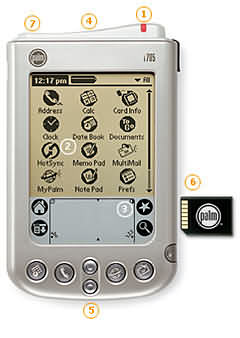 In January Palm released a new wireless pocket PC - i705 which is a PDA with a monochrome 160 x 160 screen, 8 MBytes memory, USB interface and Secure Digital and Multimedia Card support. A special transmitter-receiver will let you enter the Internet and get your e-mail via the Palm.Net. It won't replace the Palm i705 phone but it can process a heap of data received, for example, by this phone without any help from a PC. The company is going to release the final version of the Palm OS 5.0 with the Bluetooth support. By CeBIT 2002 the company will finish developing two new PDAs (supposedly, m515 and m130) with a color 320 x 320 display (16K colors) and 16 MBytes memory.  Sony announced two new pocket PCs of the CLIE line - PEG-T615C/G and PEG-S360. The top PEG-T615C/G ($380) works under the Palm OS v4.1, has a 16-bit color 320 x 320 display, a 16-bit audio controller, 4 MBytes Flash ROM and 16(!) MB RAM. The PEG-S360 ($200) is a monochrome 160 x 160 PDA which is due to replace the S320; it works on a 33 MHz Dragonball processor under the Palm OS 4.0 and has 16 MBytes memory. There was also quite a decent row of pocket computers controlled by clones of the Linux. At last Sharp released its PDA Zaurus for the international market. The localized version of the Zaurus ($500) under the Linux is expected on American shelves at the end of February. It features a 206 MHz StrongARM SA-1110 processor, 64 MBytes RAM, 16 MBytes flash, however, the Linux will get a full support of Java. Sharp said that there were already 50 Java applications written for its PDA. 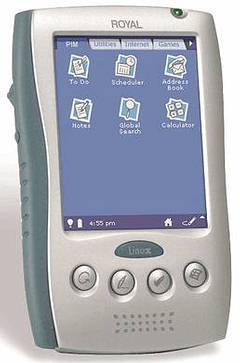 Royal (Royal Consumer Information Products) showed off at CES 2002 its PDA version working under the Linux - Lin@x. It sports a 206 MHz Intel StrongARM processor, a color 320 x 240 display, 16 MBytes Flash ROM and 32 MB RAM, a CompactFlash Type II slot and a USB interface. The price is only $300.  A rather small PDA was developed by a german company of Invair and is called Filewalker ($550). It has a 133 MHz Intel StrongARM CPU, a black-and-white 160 x 240 display (16 shades of grey), 32 MBytes RAM and 16 MBytes Flash, the Linux clone and a standard suite of software (note-book, telephone directory, calculator, post client with POP3/SMTP support etc.), and Invair plans to provide means for viewing different texts (including HTML) and graphics files (PDF, JPEG/GIF). The Filewalker allows you to text in using only one hand: there is a scrolling wheel which makes it easy to move from one letter to another. In January we got some news on the inexpensive ($200) Simputer PDA working under the Linux which is developed by the Indian engineers. 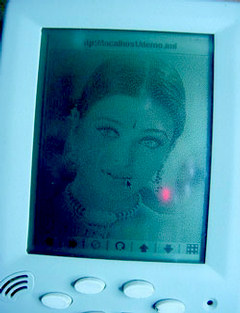 The Simputer is going to become popular in Third World countries thanks to its low price and free software. The model features 32 MBytes RAM, 24 MBytes Flash, a 240 x 320 touch screen, an integrated modem, IR- and USB ports. Samsung declared that it gave up its Yopy project,  and was going to focus on development of PDAs controlled by MS Windows Pocket PC, while all development works on Yopy are now carried out by G.mate which said it would release Yopy by Summer 2002 onto the USA market.  Samsung announced the CES 2002 PDA of quite different dimensions - Wireless Hand PC NEXiO S150 ($850), with a 5.1" 800 x 480 color display, a 206 MHz Intel StrongARM processor, 64 MBytes RAM, 32 MBytes Flash ROM, a VGA output to an external monitor, 2 USB ports, an integrated cdma2000 1x module for Internet access and controlled by the Windows CE 3.0. The NEXiO S150 has additional modules: GPRS, a digital 300,000 pixel camera and a wireless LAN 11 Mbit/s interface. However, like the I-TODO, the Samsung NEXiO S150 is meant only for the Korean market. Fujitsu was the first to announce its iPAD device under the Windows CE .NET.  The new platform from Microsoft must speed up promotion of the electronic commerce. Apart from standard functions, the iPAD can help carry out sales more effectively. The iPAD has a barcode scanner, a Smart Card reader, a digital keyboard with on-the-fly encoding function and a wireless i802.11b phone. The iPAD is shockproof - it can stand falling down on concrete from 1.5 m. 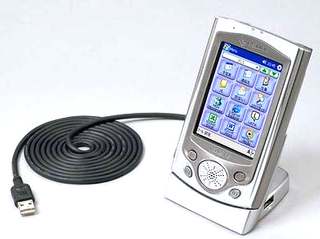 Casio Computer is going to start selling its Cassiopeia E-2000 ($460) working under the Microsoft PC Pocket 2002 which is a european version of the Japanese E-200. The model has a 206 MHz Strong ARM SA-1110 processor, 64 MBytes RAM, a color 240 x 320 display, CF Type2 and SD/MMC slots and a USB interface. 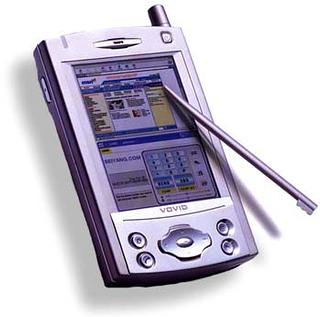 Sei Yang released a network PDA with the VoIP support - Vovid PDA. Apart from an integrated network card (802.11b), the PDA supports VoIP protocol - a voice communication via the Internet. The Vovid PDA is based on a typical 206 MHz Intel StrongARM processor, is equipped with a 3.5" color 240 x 320 screen, 32 MBytes Flash and 64 MBytes RAM, and it works under the Windows CE 3.0. Hitachi and Xybnernaut developed a wearable PDA ($1500) which will be sold by the companies under their own names - Hitachi will sell it as WIA-100NB, Xybnernaut as Poma (PersOnal Multimedia Assistant). 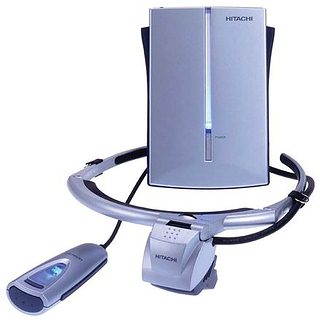 The PC consists of a system unit worn on a belt (350 g, 128 MHz 32-bit RISC SH4 processor from Hitachi, 32 MBytes RAM, 32 MBytes ROM, Compact Flash Type II slot), a video system (85 g, 640 x 480 SVGA full-color display with a viewing angle of 30 degrees) and a control device (60 g, connected via a USB port). The device operates under the Microsoft Windows CE 3.0. The new architectural solution XScale from Intel was also much spoken about but I think we should take a close look at it next time as the true facts were revealed only in February. Tablet PCs and notebooksThe only important event in this sphere was an announce by Microsoft of conceptual devices Freestyle and Mira within the .NET and eHome strategies. Mira is a hybrid of a pocket PC and a universal remote control. Working with the PC under the Windows XP the Mira can let you read the latest news in your favorite arm-chair, download a new recipe, switch on distantly an air-conditioner in the bedroom and do a heap of other things, and when coupled with the Xbox it can work as a portable game console... As Mira works in a wide sphere including home computers and other home equipment the device can put the most part of calculations on a more powerful device. As a result, there is no need in a more powerful processor and good heat dissipation; the time of running from battery is higher and price is lower. 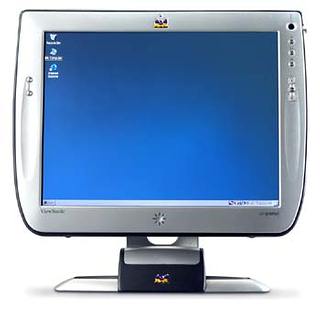 As a prototype the company showed off a 15" ViewSonic Airpanel 150 LCD with integrated wireless functions. At present, ViewSonic offers a tablet ViewPad 1000 under the Windows 2000 and ViewPad 100 which is a PDA working under the Windows CE. The Airpanel 150 which is going to be released in the middle of the next year will be a next step towards integrated solutions based on LCDs within the partner agreement with Microsoft. Now, together with Intel, National Semiconductor and Wyse Technology the companies plan to promote the line within the frames of the Windows CE.NET program. Freestyle is a conception of a new home PC under the Windows XP with a completely new user interface which according to Microsoft with the help of its partners - Hewlett-Packard, NEC and Samsung will be a multimedia center concentrating functions of a TV set, a game device, audio, video and photo centers. Realization of the Freestyle and Mira projects is planned for the second half of 2002. In January AMD announced three mobile processors , while Intel released 7.  The LOOX T9/80W notebook was announced by Fujitsu though the company didn't started its mass production. The computer has a wireless LAN AirH interface, a 10.6" 1280 x 768 screen, a 30 GBytes HDD, RAGE MOBILITY-M PCI with 4 MBytes video memory and a video-out, DVD/CD-RW drive, IEEE 1394 ports, Windows XP Home Edition, Office XP and other stuff. Unfortunately, the 800 MHz Transmeta Crusoe TM5800 failed to join such a good filling. I hope the situation will change soon. The following new Intel's processors were very popular with computer makers: 866 MHz and 850 MHz LV Mobile Pentium III-M, 750 MHz ULV Mobile Pentium III-M, 1.2 GHz, 1.13 GHz and 1.06 GHz Mobile Celeron and 650 MHz ULV Mobile Celeron - all of them are based on the 0.13-micron process. Almost all famous companies developed notebooks on these processors.  The A4 PCG-GR (BioNote GR) line of notebooks from Sony with impressive 15" 1600 x 1200 LCDs is one of the most interesting. The senior PCG-GR9F/P is based on the 1.2 GHz Mobile Pentium III-M, and the rest (PCG-GR7F, PCG-GR5F/BP and PCG-GR3F/BP) on the 1.2 GHz, 1.13 GHz and 1.0 GHz Mobile Pentium III-M. The whole line is based on the Intel 830MP chipset and contains MOBILITY RADEON-D graphics subsystem (16 MBytes). It is interesting that the IEEE 1394 interface and a video-out became standard for Sony's models. The second, office, line called Sony BioNote FX consists of PCG-FX77V/BP, PCG-FX55V/BP and PCG- FX11V and is equipped with more decent (1024 x 768) 14" and 15" LCD screens, Intel 815EM and 1 GHz Mobile Pentium III, 900 MHz Mobile Celeron. By the way, in January Sony doubled volumes of OEM orders for notebooks for Taiwanese manufacturers. ASUS and Quanta are the main manufacturers for Sony. Toshiba announced a line of notebooks on the CyberALADDiN-T chipset with integrated graphics from Trident and ALi M1535B south bridge. The Satellite 1800-S204 and 1805-S204 models are based on the 1 GHz Celeron, three other Satellite 1800-S254, 1805-S254 and 1805-S274 on more powerful 1.0 and 1.1 GHz Pentium III -M. The line of light Toshiba DynaBook SS notebooks is based on the CyberALADDiN-T chipset. The S4/275PNHW model of the B5 form-factor is only 14.9 mm thick and weighs 1.19 kg; it is equipped with a 750 MHz ULV Mobile Pentium III-M processor and a 12.1" TFT display based on the low-temperature polycrystalline silicon (1024 x 768). The stronger DynaBook V4/493OMHW of the A4 form-factor has a 933 MHz Mobile Pentium III-M processor and a 14.1" 1024 x 768 display. The DynaBook G4/510PME (A4) features a 1.0 GHz Pentium III, Intel 815 chipset, NVIDIA GeForce2 GO graphics chip (16 MBytes DDR) and a 15" 1024 x 768 display. In January Hewlett-Packard launched Pavilion zt1000 which comes with a wireless network adapter - either 802.11b or Bluetooth. The new notebook on the Mobile Celeron or Pentium III-M clocked at up to 1.2 GHz, with a 14" or 15" display and a removable DVD-ROM/CD-RW or 8x DVD-ROM drive excellently suits the company's conception of a home with several computers connected to a single network and sharing the Internet access. The HP managers consider the models with the 802.11b interface will be preferred to those with Bluetooth. 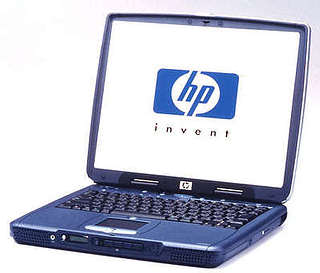 Another line from Hewlett Packard is Omnibook XE3; it comes with 1 GHz Mobile Pentium III-M and 1.06 GHz or 1.2 GHz Mobile Celeron, and a 14.1" XGA LCD. Later the company promises models with a 15.1" SXGA screen. Compaq announced Evo Notebook N110 (A4) notebooks on 1 GHz Celeron or 1 GHz Pentium III processors. The portable PCs have 14.1" 1024 x 768 displays and Trident CyberBlade i1 graphics (8 MBytes from the main memory). 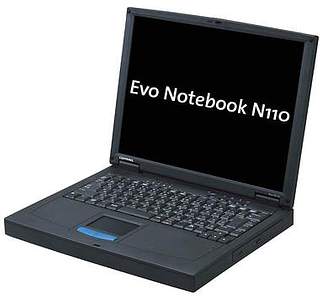 By the way, Compaq was first to announce a notebook on the new Mobile AMD Athlon 4 1500+. The Presario 700 is equipped with a 13.3" or 14.1" 1024 x 768 display. 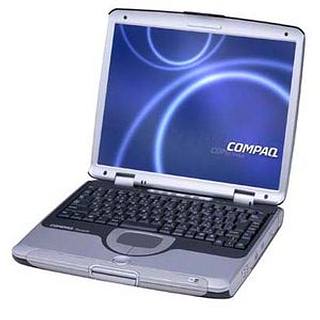 NEC started selling its LaVie line; the models are based on new processors - 650 MHz LV Mobile Celeron (LJ300/2A and LJ500/2D), 800 MHz LV Mobile Pentium III (LJ700/2D), 933 MHz, 1.0 GHz and 1.2 GHz Mobile Pentium III (LT500/2D, LT700/2D and LT900/2D), 900 MHz Mobile Celeron and 1.0 GHz Mobile Pentium III (LC300/2D, LC500/2D and LC900/2D), 900 MHz Mobile Duron, 900 MHz Mobile Celeron and 1.0 GHz Mobile Pentium III (LL500/2D, LL700/2D and LL750/2D), 850 MHz Mobile Pentium III (LaVie M LM500/2D), 1.0 GHz Mobile Athlon 4 (LH300/2A) and 1.0 GHz Intel Mobile Pentium III (LH700/2D). 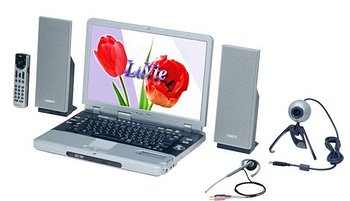 The LaVie J line with a 12.1" XGA display comes with a USB digital camera and a headset for video conferences. The LaVie T notebooks with a 15.3" display of increased brightness offers TV functions. The LaVie C line has a headset and USB cameras, as well as modern interfaces and slots, for example, for Memory Stick cards. The LaVie Pro models are delivered with the preinstalled Windows XP Professional. Hitachi launched two Flora notebooks. The Flora 200BT5M model is based on a 15" 1024 x 768 LCD, a 1.0 GHz Intel Mobile Pentium III processor and an integrated Intel 830 MG chipset. The Flora 2000BT4M notebook contains a 14.1" 1024 x 768 LCD, a 950 MHz Mobile Duron processor, a VIA KT133A chipset and an ATI RAGE MOBILITY-CL based video system (4 MBytes memory).  Matsushita released a very light (960 g!) model of the Let'snote Light CF-R1RCXR notebook with a 10.4" 1024 x 768 LCD on a 700 MHz ULV Mobile Pentium III-Mprocessor, Intel 440MX chipset and SMI Lynx 3DM+ graphics adapter (4 MBytes memory). The Toughbook CF-M34 developed by Matsushita is a dust-, water- and shockproof notebook which corresponds to the military standard; it has a color 8.4" 800 x 600 TFT LCD with brightness increased to 280 cd/m2, a 700 MHz ULV Mobile Pentium III-M processor, an Intel's 440MX chipset and SMI SM712G4 graphics (4 MBytes). 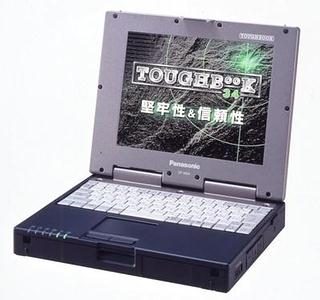 This model will be produced in two versions: with preinstalled Windows 2000 Professional (CF-M34JA2S) and with Windows 98 SE (CF-M34JA8S). Sharp released new models of the Mebius family - PC-MT1-H5, PC-MT1-H5F and PC-MT1-H5R on the i440MX-100 chipset, 750 MHz ULV Mobile Pentium-III-M and 650 MHz ULV Mobile Celeron processors. They have a 12.1" 1024 x 768 display and a video system on the ATI RAGE Mobility-M chip (4 MBytes memory).  Apart from the above models based on the mobile AMD Duron / Athlon 4 from Compaq, NEC and Hitachi I should mention two new Sharp's models of the A4 form-factor. The Mebius PC-GP1-C5U with a 15" 1400 x 1050 matrix is based on the 1.1 GHz AMD Atlhon 4 and VIA ProSavage KN133. The second cheaper model Mebius PC-CB1-R5S with a 12.1" 1024 x 768 screen is assembled on a 850 MHz AMD Duron and VIA ProSavage KN133 chipset. Digital photographyThe most significant event in this sphere was a release by Fujifilm of three new cameras of the FinePix series; one of them - 6.17 Mpixel FinePix S2 Pro D-SLR ($4200) is the first model for the last several months with a matrix more than 5 Mpixel.  The 6.17 Mpixel SuperCCD III matrix of the S2 Pro camera allows making 12.1Mpixel (4256 x 2848) shots. The new model has a Nikon F80/N80 case, can work with D-type AF Nikkor optical system (except IX-Nikkor), PC Micro-Nikkor 85mm f/2.8D, AF Nikkor and other D-type (except AF Nikkor for F3AF), AI-P Nikkor, IX-Nikkor, supports CCD-Raw format and sensitivity within ISO100 - ISO1600. Record formats - 4256 x 2848 (12.1Mpixel), 3024 x 2016 (6.1 Mpixel), 2304 x 1536 (3.5 Mpixel), 1440 x 960 (1.4 Mpixel), file formats - JPEG (EXIF), TIFF-RGB (8-bit), TIFF-YC (8-bit), CCD-Raw (12-bit), uncompressed CCD-Raw file (16-bit TIFF-RGB) can be up to 72 MBytes. The optical viewfinder of the camera integrates dioptre control (-1.8m-1 to +0.8m-1); SmartMedia (up to 128 MBytes, Slot 1) and Compact Flash Type I/II (including IBM Microdrive, Slot 2) cards are supported.  The Fujifilm FinePix S602 Zoom camera ($1100) which is due to replace the popular FinePix 6900 Zoom is equipped with a 1/1.7" 3.1Mpixel CCD Fujifilm SuperCCD III matrix and can record images of 2832 x 2128, 2048 x 1536, 1280 x 960 and 640 x 480 in JPEG and TIFF formats. The S602 Zoom comes with a lens with a 6x optical zoom (Super EBC, F2.8 - F3.1, 35 - 210 mm focal length in 35 mm equivalent). The relative sensitivity is ISO160 - ISO1600, SmartMedia (up to 128 MBytes, 16 MBytes supplied, Slot 1) and Compact Flash Type I/II (combined with IBM Microdrive, Slot 2) are supported. 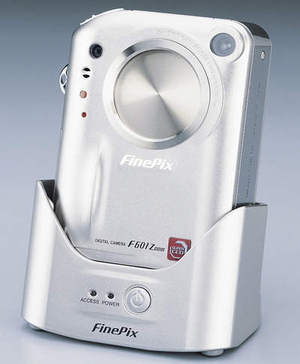 The third camera is FinePix F601 Zoom ($599); it is meant to replace the 6800Z. The camera has a 1/1.7" 3.1Mpixel CCD Fujifilm SuperCCD III matrix, works with images of 2832 x 2128, 2048 x 1536, 1280 x 960 and 640 x 480 only in the JPEG format, has a lens with a 3x optical zoom (Super EBC, 36 - 108 mm in 35 mm equivalent). The relative sensitivity of the FinePix F601 Zoom is ISO160 to ISO1600; SmartMedia cards (up to 128 MBytes, 16 MBytes supplied) are used as storage devices.  Minolta released two also interesting cameras in January. The DiMAGE S404 is a new version of the DiMAGE S304, it took from the Minolta DiMAGE 7 such features as the GT LENS optical system (4x optical zoom, 35 - 140 mm in 35mm equivalent, 2x digital zoom, 35 - 308 mm in 35 mm equivalent), CxProcess technology and a high-speed logic. The camera has a 1/1.8" 4.1Mpixel (3.87 Mpixel effective) CCD matrix from Sony (G-R-G-B filters), works with shots in 2272 x 1704, 1600 x 1200, 1280 x 960 and 640 x 480 formats (TIFF, JPEG) with the side ratio of 4:3. The relative sensitivity is ISO64 - ISO400, CompactFlash cards can be used as a storage device (16 MBytes supplied, Microdrive unsupported). 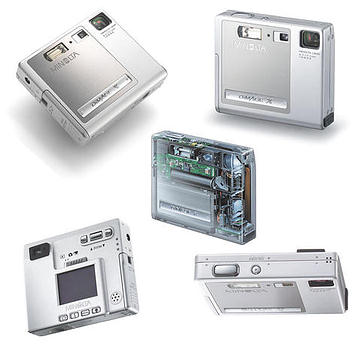 The other Minolta's camera is DiMAGE X ($550); it is an elegant 2.1Mpixel model. The camera has a 1/2.7" 2.11Mpixel CCD matrix and an optical system with a 3x optical and 2x digital zoom (37 mm - 111 mm in the 35 mm equivalent, F2.8 - 3.6). The shots can be of 1600 x 1200, 1280 x 960, 640 x 480; SD/MMC cards supported (8 MBytes SD supplied). The camera has the lowest preparation time - only 1.8 s. 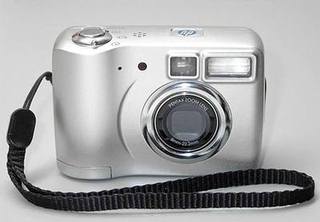 Hewlett-Packard showed off its new 4Mpixel Photosmart 812 camera ($599) with the Pentax lens (3x optical zoom and 7x digital one). In January Sony announced only two cameras of the Mavica Dual-Media series - a 1.2Mpixel FD100 camera ($400) and a 2.1Mpixel FD200 one ($500). The Dual-Media means that the cameras can record shots on 3.5" diskettes or MemoryStick flash cards. 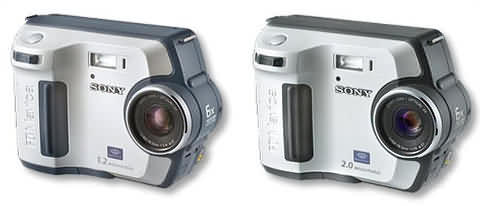 Both cards are equipped with a lens having a 3x optical zoom; and the FD200 has apart a USB interface.  Matsushita announced a new line of digital cameras of the LUMIX series. The DMC-LC20 ($350), DMC-F7 ($500), DMC-LC40 ($700) and DMC-LC5 ($900) cameras got an optical system from Leica Camera AG and Panasonic technologies. The DMC-F7 and DMC-LC20 models are equipped with a 2.1 Mpixel CCD matrix, the DMC-LC40 and DMC-LC5 have a 4.0 Mpixel CCD one (3.9 Mpixel effective). The DMC-F7 (2x optical zoom) and the DMC-LC20 (3x optical zoom) sport the Leica DC Vario-Elmart optical system, while the DMC-LC40 and DMC-LC5 have the Leica DC Vario-Summicron one (3x optical zoom) with F2.0 aperture. Multimedia January brought in a new version of the RightMark Audio Analyzer program - 3.2. It works flawlessly under the Windows 2000 and Windows XP, has a graph anti-aliasing when HTML reports are generated, and some errors are eliminated. The new RightMark Audio Analyzer is named RMAA Acoustics Testing Edition (RMAA-AE). The program is meant for testing acoustic systems and based on the v3.2 measuring code, like the RMAA. For testing an AFC of acoustic system there are two types of test signals: music noise and a swept sine. The new version if free, and you can get the copy, source codes, read the latest news, learn about the measurement technique, join the forum and ask questions at the RMAA's site: English Version. Creative released the first external Sound Blaster Extigy sound card ($150). The card provides normal operation with a multichannel 24-bit/96 kHz sound with the SNR of 100 dB, channel crosstalk of -97 dB, THD (Total Harmonic Distortion + Noise, 1 kHz, A curve) of 0.006% and a frequency range (at -3 dB) of 10 Hz to 23 kHz. 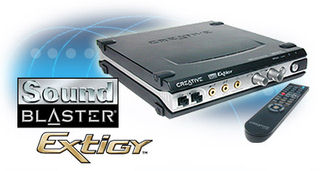 The Sound Blaster Extigy supports EAX ADVANCED HD (Audio Clean-Up, Time Scaling, DREAM) and CMSS technologies (Creative Multi-Speaker Surround). The latter allows owners of 5.1 acoustic systems to get a higher-quality stereo signal; with headphones or two speakers the CMSS allows for a better stereo effect. The rear panel of the Sound Blaster Extigy is equipped with connectors for an additional amplifier or for taking a signal to acoustic systems. The Sound Blaster Extigy has also optical and MIDI inputs/outputs, SPDIF-in, linear-in and a mic-in.  Creative started selling its SoundBlaster Live! Platium 1394 ($50) - a system for upgrading its SoundBlaster Live! card. The system consists of the IEEE-1394 card with PCI interface which is to be connected to the SoundBlaster Live!, a special front panel and a remote control. TerraTec released the first solid 5.1-channel DMX 6fire24/96 Sound System card ($190). 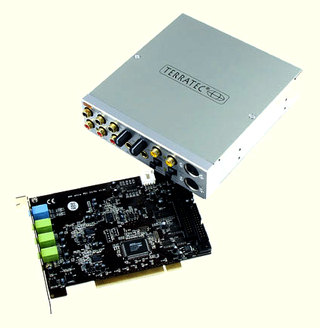 The card is a 6-channel PCI 24-bit/96 Hz solution based on the ICE1712-BBABA, a professional Envy 24 DSP chip from IC Ensemble - and, in fact, on a 24-bit/96-kHz DSP chip, and the AKM AK4524 codec. The card combines professional and multimedia capabilities, i.e. both ASIO and 24/96. Besides, the DMX 6fire24/96 Sound System provides a 6-channel sound in movies and games with EAX2.0 and Sensaura support (DS3D, A3D 1.x, EAX 1.0/2.0, 3D sound for 2.1, 4.1 and 5.1 systems, Dolby Digital decoding, AC3 and DTS for DVD Video). Liek the Platinum line from Creative, the DMX 6fire24/96 comes with an external unit. 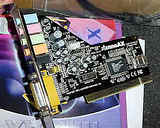 One more 5.1-channel sound solution was demonstrated in January by InnoVision. Its Audio Extreme 5 ($30) is going to improve motherboards without an integrated 6-channel sound on the CMI8738 from C-Media. The Audio Extreme 5 based on this chip has a full set of inputs/outputs including digital ones - optical and coaxial. Altec Lansing showed off at CES 2002 several new acoustic lines. Unsophisticated speakers of the XA series are meant for users of XBox, PS2 and GameCube game consoles: XA3001 is a subwoofer for TV speakers, XA3021 - 2.1-, XA3051 is a 5.1-piece entry-level system. Besides, they showed the 200 series of Altec Lansing acoustic system which consists of 251, 221 and 220 models. The 251 ($100) is a 5.1-channel system of 90 W of total power, there are 5 satellites and a subwoofer with a 5.25" loudspeaker's cone. The 221 ($50) is a 3-piece system: 2 satellites and a subwoofer with a 4" speaker, the total power is 50 W. The 220 ($30) consists of two speakers. 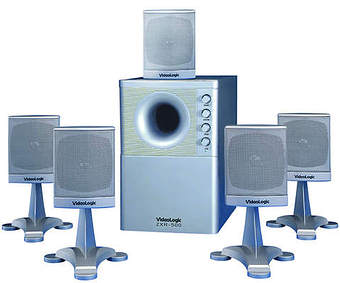 Videologic launched its 5.1-peice ZXR-500 ($115) system of 65 W RMS (satellites
of 8 W RMS plus a subwoofer of 25 W RMS), the input sensitivity is 350
mV. The subwoofer with 4 Ohm of input resistance consists of a 5" speaker
and an integrated amplifier (25 W RMS, 20 Hz - 20 kHz frequency range)
with system regulators. Satellites are 5 identical speakers with 3" loudspeakers
and 6 Ohm resistance. Nothing extraordinary.
Write a comment below. No registration needed!
|
Platform · Video · Multimedia · Mobile · Other || About us & Privacy policy · Twitter · Facebook Copyright © Byrds Research & Publishing, Ltd., 1997–2011. All rights reserved. |